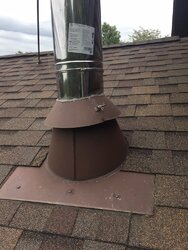I'm getting water on top of my stove during heavy rains with strong cross winds. It's only on the outside of the stove pipe, and my best guess is the water is being blown up the chimney pipe roof flashing, under the storm collar and into the ventilation slots. I have SuperVent pipe.
Searching this site I found a post from July 23, 2008, from a poster that says he's VP of Marketing for Selkirk. (Link and text below) He says to use duct tape to seal the vents, because the ventilation is only needed for installations with attics. I have a cathedral ceiling and it sounds like this fix could apply to me, and I would only tape the down slope side. Does anyone have any opinions on using duct tape to block the vents, or any better ideas to prevent water from coming in through the vents?
https://www.hearth.com/talk/threads/leak-around-wood-stove-chimney.17750/#post-269877

Searching this site I found a post from July 23, 2008, from a poster that says he's VP of Marketing for Selkirk. (Link and text below) He says to use duct tape to seal the vents, because the ventilation is only needed for installations with attics. I have a cathedral ceiling and it sounds like this fix could apply to me, and I would only tape the down slope side. Does anyone have any opinions on using duct tape to block the vents, or any better ideas to prevent water from coming in through the vents?
https://www.hearth.com/talk/threads/leak-around-wood-stove-chimney.17750/#post-269877


